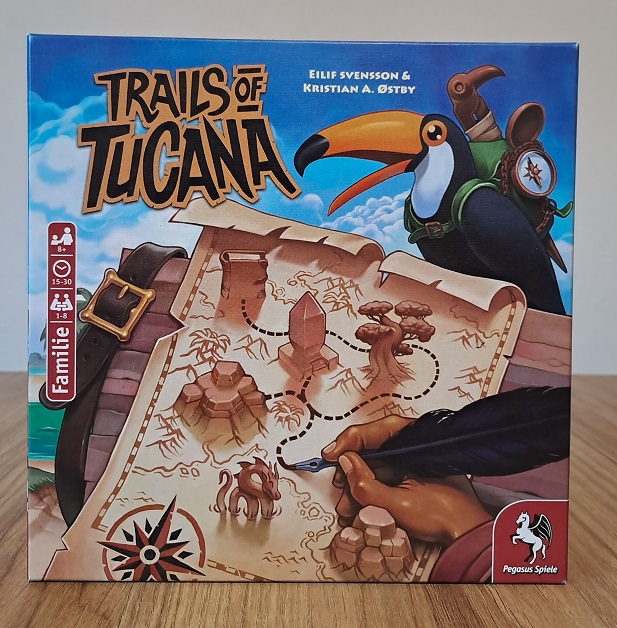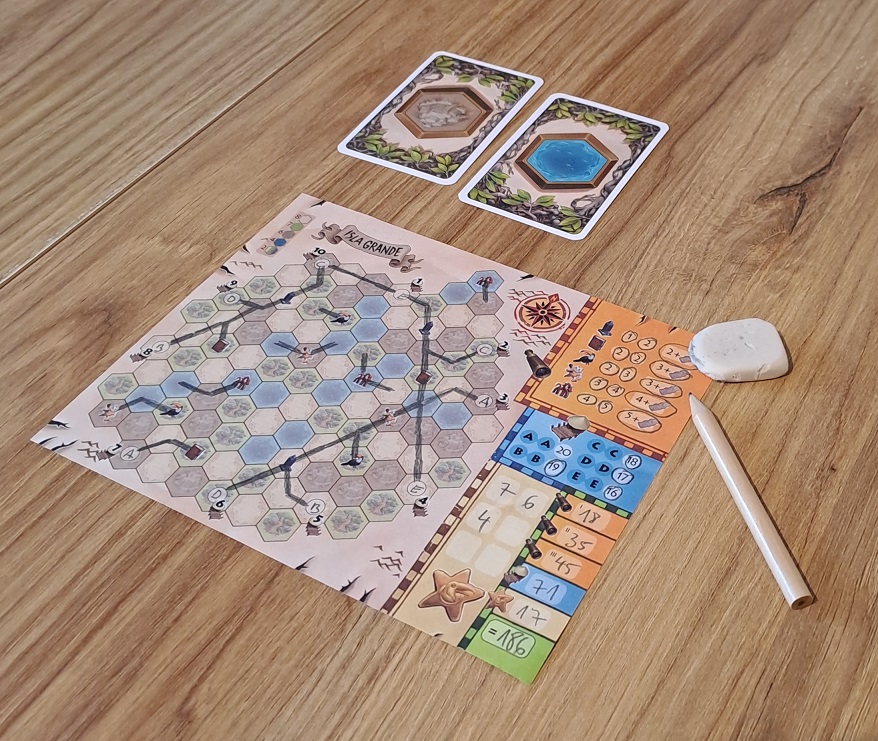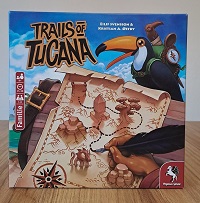In this article, you can read a review of a simple flip-and-write board game, Trails of Tucana. Its attractive appearance and easy-to-learn gameplay make it a perfect game for all ages.
Introduction to Trails of Tucana Review
Among all the board gaming spectrum, flip and writes (or roll and writes) form a peculiar niche. You get a piece of paper and a pencil and that’s all there is to your playing pieces. Your play area is also highly independent from the central, “flipping” part of the game, meaning these games scale particularly well to all player counts.
Also, it doesn’t really matter if you mess up your piece of the paper, because you’re not affecting anyone else – it’s like playing multiplayer solitaire.
That’s why these games are one of my favorite genres to play with kids (kids love to draw, obviously). The parents can play competitively, while at the same time, kids can play seriously, mess around, or even quit mid-game if they run out of concentration.
For a long time, our family’s go-to flip and write was Cartographers, but I’ve snatched up Trails of Tucana from a local second-hand market recently as I assumed its simplicity and cuteness will be more suited for my 7 and 4-year-olds. And also, that it will offer enough strategic depth to keep the parents interested, too.
Trails of Tucana Facts

Designers: Eilif Svensson, Kristian Amundsen Østby
Published by: Aporta Games
Players: 1-8+ (works well with all numbers)
Complexity: light
Playing time: 15-20 minutes
Concept of the game
Each player receives a hex map, filled with 4 terrain types: water, desert, jungle, and mountains. On the edges of the map, there are randomly distributed villages. Your goal is to connect the same types of villages with a path across the island.
Drawing the path could not be easier. On each turn, two cards are drawn, showing terrain types and you have to draw a line between the depicted terrain types anywhere on the map. The idea is so simply intuitive, that you can learn in a minute.
The only other thing to keep in mind is the landmark icons that grant extra points or even allow you to draw a free path when you connect them.
You go through the deck twice (thrice for the larger B-side map) and after that, you add up the points. Points for the villages you connected (you get an extra bonus if you’re the first to do so) and the icons you connected. The final scoring is all very straightforward 1st-grade maths, making it super easy to understand what to do to score big points.
Looks
While the gameplay is rather abstract, the game looks solid enough to attract customers (=kids in a store). The box art is colorful and appealing, the in-game graphic design is easy to read, the landmarks easy to recognize, and so on. I should mention that the paper sheets are color printed on both sides, which helps with the overall prettiness of the game.

Gameplay Impressions
A game of Trails of Tucana is ready in no time. You deal out the sheets and pencils, shuffle the decks, and lay out the bonus cards. The same rapidness is true for the teardown.
Combining this with the overall short and flowing gameplay, Trails of Tucana works great as a filler game or when you don’t have too much time (or attention span). Despite the short gameplay, the time spent playing the game is highly engaging – players take their turns simultaneously, meaning there’s very little downtime.
The gameplay itself is nice and relaxing. Seeing your trail extend (in the right direction, hopefully) is satisfying and encouraging. While the concept is simple, it does offer a decent amount of depth. You’ll always have several options on where to draw the next path, so important decisions will have to be made on every turn.
Additional depth comes from connecting the landmarks, which allows you to draw paths for free. Often you’ll draw a path just for the landmark – and timing is also important, as it can allow you to chain bonuses of different landmarks together. This way, you can tie up several loose ends of your paths in one go.
Adding to the game’s longevity are variable setups, which ensure players have different layouts of villages on their maps, diversifying play. The number of sheets included is plentiful and there’s also a Ferry expansion available if you want more. It introduces two new maps.
But make no mistake, Trails of Tucana is still a family-friendly gateway game and as such has little long-term appeal for more experienced board gamers. Yes, it’s fun and somewhat challenging connecting the villages, but you’ll see everything there is to the game in four plays.
As already mentioned, since every play is alone with their sheet, the game plays well with all player numbers – there’s even a solo mode included. But be aware that besides bonuses for the paths, there’s absolutely no player interaction in Trails of Tucana.
Conclusion
Despite all this, I really like Trails of Tucana. It’s everything I expected from it: simple, quick, adorable, satisfying, and fun. It’s perfect to play with kids and it’s already a hit in our house.
Its value is questionable if your group consists of more experienced board gamers, but even they may appreciate it as an occasional filler. Final score – thumbs up from me!
Do you like what you just read? Consider subscribing for more content:
